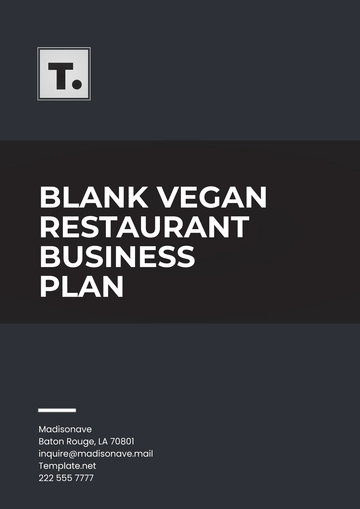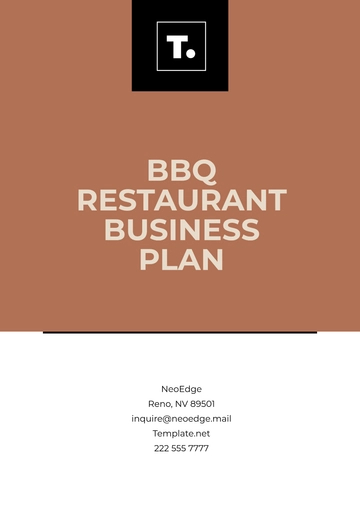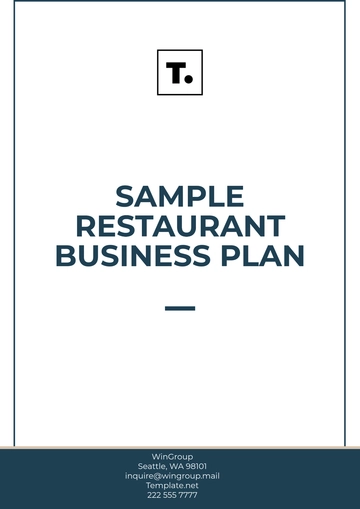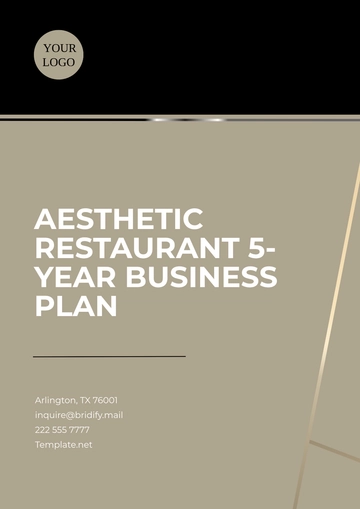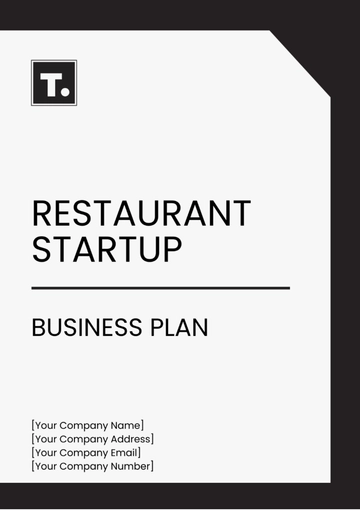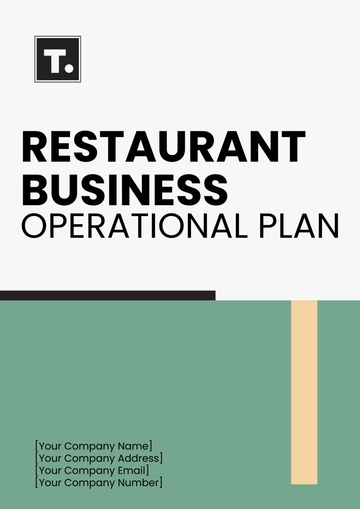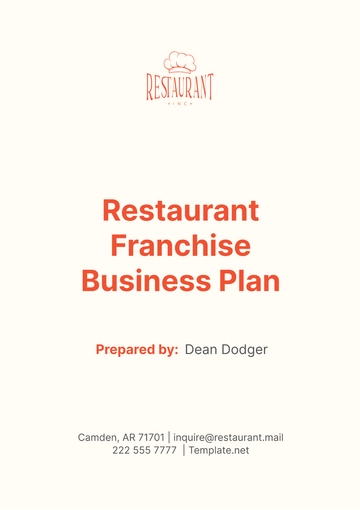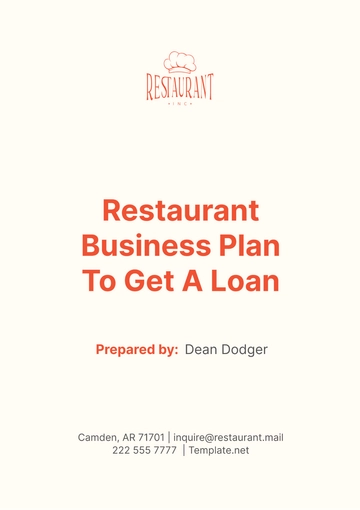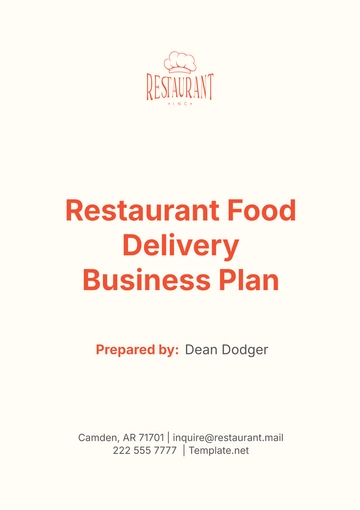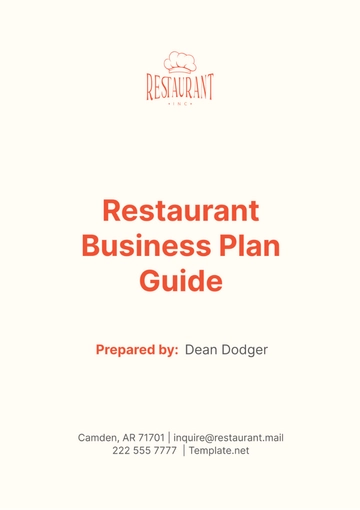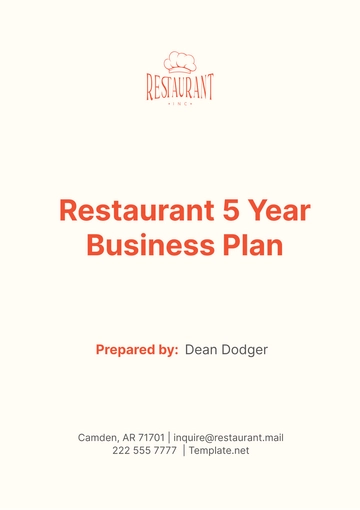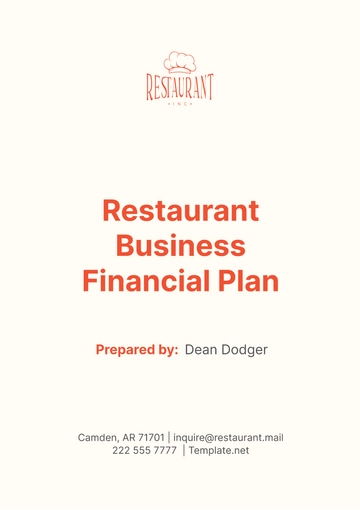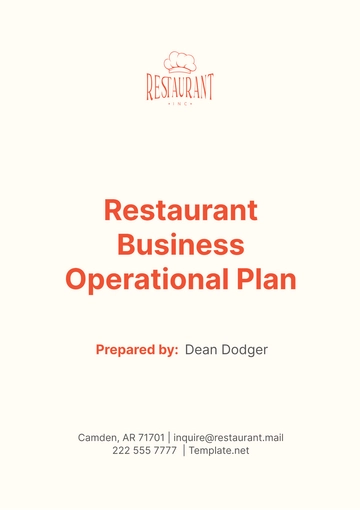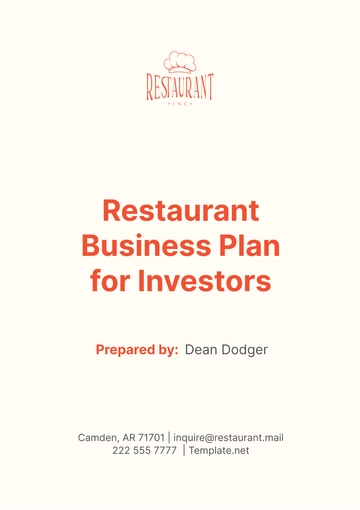Free Restaurant Business Financial Plan
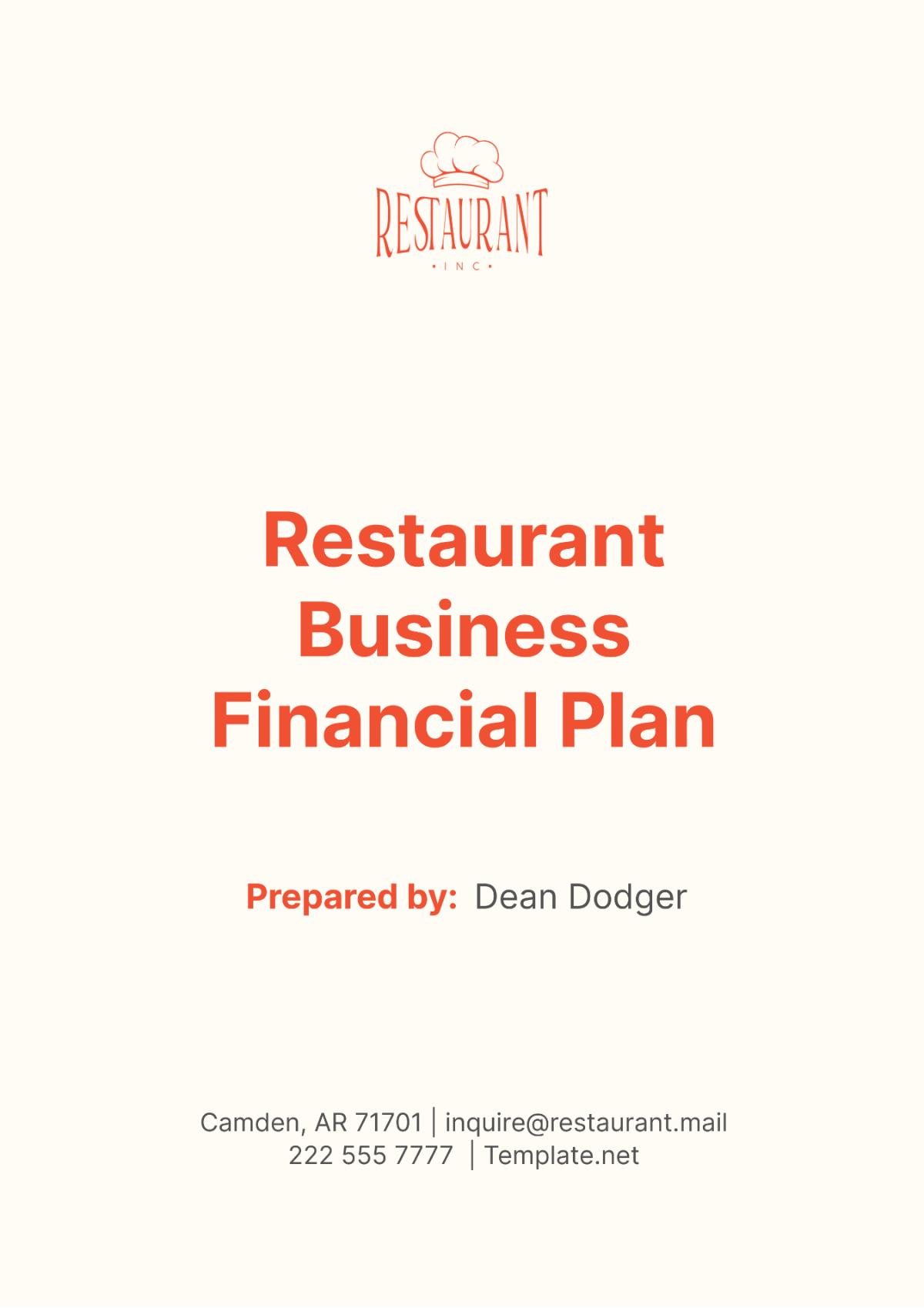
I. Executive Summary
The financial plan for [Your Company Name] is a comprehensive document that outlines the financial strategy for the restaurant over the next five years, 2051 to 2055. It serves as a roadmap for the restaurant’s financial decisions, ensuring that all financial activities align with the restaurant’s overall business objectives. The plan includes detailed financial projections, providing an estimate of the restaurant’s revenues, expenses, and profitability over the next five years.
These projections are based on a thorough analysis of the restaurant’s past financial performance, current market conditions, and future growth prospects. They provide a realistic and achievable financial target for the restaurant, serving as a benchmark against which the restaurant’s actual financial performance can be measured and evaluated. [Your Company Name] projected revenue in the first year is $500,000, with a steady growth rate of 15% per year over the next five years, and major expenses including labor costs of $150,000, marketing expenses $50,000 in the first year and capital expenditures of $100,000 annually.
The financial plan also includes a detailed breakdown of the restaurant’s financial objectives, financial strategies, and risk management strategies. These elements of the plan provide a clear direction for the restaurant’s financial management, ensuring that all financial activities are focused on achieving the restaurant’s financial objectives, maximizing profitability, and minimizing financial risk. By following this plan, [Your Company Name] can ensure its financial stability, profitability, and growth, enabling it to continue providing excellent food and service to its customers, and contributing to its success in the competitive restaurant industry.
II. Financial Objectives
The financial objectives for [Your Company Name] are designed to ensure the financial stability and growth of the restaurant over the next five years. These objectives serve as benchmarks against which the restaurant’s financial performance can be measured and evaluated:
A. Profitability
Achieving profitability is a key objective for [Your Company Name]. This involves:
Optimizing Expenses: Reducing costs wherever possible without compromising on the quality of food or service. This includes negotiating with suppliers for better prices, reducing waste, and improving operational efficiency.
Increasing Revenues: This involves attracting more customers, increasing the average spend per customer, and introducing new revenue streams such as catering services or special events.
Maintaining Positive Net Profit Margin: Ensuring that revenues exceed expenses to maintain a positive net profit margin. This requires careful financial management and regular review of financial performance.
B. Cash Flow Management
Sustaining adequate cash flow is crucial for the day-to-day operations and long-term stability of [Your Company Name]. This involves:
Managing Receivables and Payables: Ensuring that payments from customers are received in a timely manner and that payments to suppliers and employees are made on time.
Maintaining Cash Reserves: Keeping a reserve of cash to cover unexpected expenses or downturns in business. This provides a safety net and ensures that the restaurant can continue to operate in difficult times.
Investing in Growth: Using surplus cash to invest in opportunities for growth, such as expanding the restaurant or introducing new menu items.
C. Market Share Expansion
Expanding market share involves attracting more customers and increasing sales. This involves:
Attracting New Customers: Implementing marketing strategies to reach new customers, such as social media marketing, local advertising, and special promotions.
Retaining Existing Customers: Providing excellent service and quality food to encourage repeat business. This also includes implementing a customer loyalty program to reward repeat customers.
Expanding into New Markets: Considering opportunities to expand into new markets, such as catering services or opening new locations.
Building Brand Recognition: Developing a strong brand that is recognized and trusted by customers. This involves consistent branding, maintaining high standards, and building a positive reputation.
Monitoring Market Trends: Keeping up-to-date with market trends and adapting the business model, menu, or marketing strategies as needed.
III. Revenue Projections
Projected revenues are calculated based on current market trends, competitive analysis, and the marketing strategies outlined in the plan. This following table showcase a detailed forecast for the next five years, highlighting expected growth rates and potential market expansions:
Year | Projected Revenue | Growth Rate |
|---|---|---|
2051 | $500,000 | 15% |
2052 | $575,000 | 15% |
2053 | $661,250 | 15% |
2054 | $760,437 | 15% |
2055 | $874,503 | 15% |
The projected revenue for the year 2051 is $500,000. This figure is based on the restaurant’s current revenue, expected growth rate, and planned marketing initiatives. It takes into account factors such as customer spending habits, menu pricing, and the restaurant’s customer base.
In 2052, the projected revenue is expected to increase by 15% to $575,000. This growth is expected to be driven by the restaurant’s ongoing marketing efforts, menu innovations, and excellent customer service.
By 2053, the projected revenue is expected to reach $661,250, reflecting a consistent growth rate of 15%. This growth will be supported by the restaurant’s continued focus on providing excellent food and service, attracting new customers, and retaining existing ones.
In 2054, the projected revenue is expected to increase to $760,437. This continued growth is expected to result from the restaurant’s ongoing efforts to expand its customer base, innovate its menu, and enhance its service.
By 2055, the projected revenue is expected to reach $874,503. This represents a significant increase from the restaurant’s current revenue and reflects the success of its financial strategies and business model.
The revenue projections for [Your Company Name] are based on a thorough analysis of the restaurant’s financial performance, market trends, and competitive landscape. They reflect the restaurant’s potential for growth and profitability in the coming years. These projections will be reviewed and updated regularly to ensure they remain accurate and relevant.
IV. Expense Forecast
The financial stability of [Your Company Name] also depends heavily on effectively managing expenses. A strategic approach to cost management will ensure that the restaurant remains profitable and financially sound. The following table outlines expected costs including but not limited to labor, marketing, and capital expenditures:
Type of Expense | 2051 | 2052 | 2053 | 2054 | 2055 |
|---|---|---|---|---|---|
Labor | $150,000 | $157,500 | $165,375 | $173,644 | $182,326 |
Marketing | $50,000 | $52,500 | $55,125 | $57,881 | $60,775 |
Capital Expenditures | $100,000 | $100,000 | $100,000 | $100,000 | $100,000 |
A. Labor
Labor is one of the most significant expenses for [Your Company Name]. This includes salaries, wages, and benefits for all restaurant staff. Effective labor management strategies, such as optimizing staff schedules and investing in staff training and development, can help to control labor costs while maintaining high service standards.
B. Marketing
Marketing expenses include costs associated with promoting the restaurant and attracting customers. This includes advertising, promotional events, and digital marketing efforts. Effective marketing strategies can help to increase the restaurant’s customer base and revenue, providing a good return on investment.
C. Capital Expenditures
Capital expenditures refer to the funds used by the restaurant to acquire, upgrade, and maintain physical assets such as kitchen equipment, furniture, and the restaurant premises. Regular investment in capital expenditures is necessary to ensure the restaurant can continue to provide high-quality food and service.
The expense forecast for [Your Company Name] provides a detailed overview of the restaurant’s expected costs over the next five years. It highlights the importance of effective cost management in ensuring the restaurant’s financial stability and profitability. By carefully managing expenses and investing in areas that contribute to the restaurant’s growth and success, [Your Company Name] can achieve its financial objectives and ensure a sustainable future.
V. Financial Strategies
Financial strategies for [Your Company Name] focus on optimizing resource allocation, pursuing funding opportunities, and maintaining a strong balance sheet. Effective financial management will ensure that all financial objectives are met and will support sustainable business growth.
A. Resource Allocation
Optimizing resource allocation involves ensuring that resources are used efficiently and effectively. This includes:
Inventory Management: Effective inventory management can reduce waste and lower costs. This involves accurately forecasting demand, timely ordering of supplies, and proper storage to prevent spoilage.
Labor Scheduling: Efficient labor scheduling can ensure that the restaurant is adequately staffed during peak times while avoiding overstaffing during slower periods. This involves understanding the patterns of customer traffic and scheduling staff accordingly.
Energy Efficiency: Implementing energy-efficient practices can lower utility costs. This could include using energy-efficient appliances, implementing energy-saving practices, and regular maintenance to ensure optimal performance of equipment.
Waste Reduction: Reducing waste can result in significant cost savings. This involves careful portion control, re-purposing leftovers where safe and appropriate, and recycling or composting waste.
B. Funding Opportunities
Pursuing funding opportunities can provide additional capital for expansion and growth. This includes:
Business Loans: Applying for business loans can provide the necessary capital for expansion or improvement projects. This involves understanding the terms and conditions of the loan and ensuring timely repayment.
Investor Funding: Attracting investors can provide a significant boost to the restaurant’s capital. This involves presenting a compelling business plan and demonstrating the potential for return on investment.
Grants: Applying for grants can provide funds that do not need to be repaid. This involves researching available grant opportunities and meeting the application requirements.
Crowdfunding: Crowdfunding can be an innovative way to raise funds for specific projects. This involves creating a compelling campaign and promoting it to potential contributors.
C. Balance Sheet Management
Maintaining a strong balance sheet involves managing assets and liabilities effectively. This includes:
Cash Flow Management: Effective cash flow management ensures that the restaurant has sufficient cash to meet its financial obligations. This involves timely collection of receivables, judicious payment of payables, and maintaining a cash reserve for emergencies.
Debt Management: Prudent debt management ensures that the restaurant can meet its debt obligations without straining its finances. This involves choosing affordable financing options, timely repayment of debts, and maintaining a healthy debt-to-equity ratio.
Asset Management: Effective asset management ensures that the restaurant’s assets are used efficiently and maintained properly. This involves regular maintenance of equipment, prudent investment in assets, and disposal of obsolete or unproductive assets.
Capital Structure: Maintaining an optimal capital structure ensures financial stability and minimizes the cost of capital. This involves maintaining a balance between debt and equity financing.
VI. Risk Management
Risk management involves identifying potential risks that could negatively impact the restaurant’s finances and implementing strategies to mitigate these risks. Effective risk management can help to safeguard the restaurant’s assets and financial future.
A. Financial Risk Management
Financial risk management involves identifying and mitigating risks related to the restaurant’s finances. This includes:
Cash Flow Risk: Cash flow risk involves the risk of not having enough cash to cover expenses. This can be mitigated by effective cash flow management, maintaining a cash reserve, and having access to credit facilities.
Credit Risk: Credit risk involves the risk of customers or other parties not paying their debts. This can be mitigated by having clear credit policies, conducting credit checks, and following up on overdue payments promptly.
Interest Rate Risk: Interest rate risk involves the risk of interest rates increasing, which can increase the cost of debt. This can be mitigated by locking in interest rates where possible, and monitoring interest rate trends.
Currency Risk: If the restaurant imports goods or has overseas operations, currency risk involves the risk of exchange rates fluctuating. This can be mitigated by hedging foreign exchange risk, negotiating prices in local currency, and monitoring exchange rate trends.
Inflation Risk: Inflation risk involves the risk of prices increasing, which can erode purchasing power. This can be mitigated by factoring inflation into financial forecasts, adjusting prices as necessary, and improving operational efficiency to reduce costs.
B. Operational Risk Management
Operational risk management involves identifying and mitigating risks related to the restaurant’s operations. This includes:
Supply Chain Risk: Supply chain risk involves the risk of disruptions to the supply of goods. This can be mitigated by having multiple suppliers, maintaining adequate inventory levels, and developing contingency plans.
Health and Safety Risk: Health and safety risk involves the risk of accidents or health and safety incidents. This can be mitigated by providing health and safety training, maintaining a safe work environment, and complying with health and safety regulations.
Reputation Risk: Reputation risk involves the risk of damage to the restaurant’s reputation. This can be mitigated by providing excellent customer service, managing customer complaints effectively, and maintaining high standards of food safety and quality.
Regulatory Risk: Regulatory risk involves the risk of non-compliance with laws and regulations. This can be mitigated by staying up-to-date with relevant laws and regulations, conducting regular compliance audits, and providing compliance training to staff.
VII. Conclusion
In conclusion, the financial plan for [Your Company Name] provides a comprehensive and strategic approach to the restaurant’s financial management over the next five years. It outlines key financial objectives, detailed financial projections, and effective financial strategies that align with the restaurant’s overall business objectives. By adhering to this plan, [Your Company Name] can ensure its financial stability, profitability, and growth, thereby securing its position in the competitive restaurant industry.
Moreover, this financial plan serves as a dynamic tool for [Your Company Name], allowing for adjustments and refinements as market conditions change and the restaurant grows. It underscores the commitment of [Your Company Name] to prudent financial management, strategic growth, and exceptional service delivery. By following this plan, [Your Company Name] is well-positioned to navigate financial challenges, seize growth opportunities, and continue providing excellent food and service to its valued customers. This commitment to financial planning and management is integral to the ongoing success and sustainability of [Your Company Name].
- 100% Customizable, free editor
- Access 1 Million+ Templates, photo’s & graphics
- Download or share as a template
- Click and replace photos, graphics, text, backgrounds
- Resize, crop, AI write & more
- Access advanced editor
Plan for financial success with the Restaurant Business Financial Plan Template only on Template.net! This tool provides an editable platform to outline financial projections and strategies for your restaurant business. Customize the plan using its customizable features and the advanced AI Editor Tool to make informed decisions to drive profitability!
You may also like
- One Page Business Plan
- Coffee Shop Business Plan
- Restaurant Business Plan
- Food Business Plan
- Real Estate Business Plan
- Executive Summary Business Plan
- Cover Page Business Plan
- Nonprofit Business Plan
- Daycare Business Plan
- Construction Business Plan
- Startup Business Plan
- Medical Business Plan
- Bakery Business Plan
- Service Plan
- Hotel Business Plan
- Catering Business Plan
- School Business Plan
- Healthcare Business Plan
- Transportation Plan
- Sports Plan
- Car Wash Business Plan
- Salon Business Plan
- Clothing Business Plan
- Farming Business Plan
- Boutique Plan
